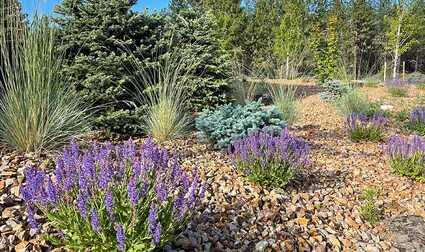Xeriscaping for a dry climate
Last updated 7/5/2022 at Noon
According to the U.S. Environmental Protection Agency, about 30 percent of water usage for the average American family occurs outdoors, such as watering lawns and gardens. The same agency says that in the West, where water is lost almost instantaneously to either the blazing sun or thirsty vegetation, outdoor water usage increases to about 60 percent of total household use.
John Berggren, a water policy analyst with the conservation organization Western Resource Advocates recently said: “In the summer, a big chunk of the water supply in the West goes to irrigating non-native turf grass, which is what is generally used for lawns.”
There are benefits to turf grass, Berggren acknowledges. It’s aesthetically pleasing, and cooling, helping to reduce the urban heat island effect. It also provides recreation for kids and pets to run and play, and as parks and ball fields. Grasses native to the West don’t offer the same recreational benefit.
The typical grass used for homes, parks, and sports fields here in Oregon is Kentucky bluegrass — not native to the West, which is why it requires so much water for upkeep. Coincidentally, Oregon is the grass seed capital of the world. It supplies about 75 percent of all grass seed produced in the world including perennial ryegrass and Kentucky bluegrass. It’s a multi-billion dollar industry.
In so many words, Berggren and the EPA are telling us to get rid of our lawns in view of the megadrought they say we are in. But they are not saying plant your yard in concrete. To the contrary. Go native!
“We have so many beautiful native plants that are adapted to our climates out here in the West,” he said. “You’ll have lots of color. You can have lots of green.”
Once established, native plants require little water “beyond normal rainfall,” according to the EPA.
Along with the aesthetics, the plants will also provide collection for storm water runoff and water quality benefits, Berggren elaborated.
Some Oregon cities are urging citizens to cut off watering letting their lawns turn brown in the summer. Ashland, in the Rogue Valley, 12 miles from the California border — like Sisters, abutting a National Forest and highly prone to wildfire — does not water city-owned lawns, including its municipally owned golf course. Not the prettiest of solutions.
Oregon State Univeristy (OSU) is a leader in xeriscaping promoted as water-wise gardening. Associate Professor, Amy Jo Detweiler says: “A water-wise landscape may conjure up images of a dry, desert-like ‘blandscape.’ But, in fact, a well-planned, water-wise landscape can be attractive, colorful, and rewarding. A water-wise garden does not mean limiting your plant selection to only native plants or plants that use low amounts of water; it can incorporate hundreds of plant choices, including trees, shrubs, evergreens, perennials, and grasses.”
In Sisters Country, with only three to six inches of natural precipitation during the growing season (April through October), water use for our landscapes is a very important consideration. Each year, a typical Central Oregon resident uses over 50 percent of his or her total water consumption for outdoor landscape according to OSU.
We live in a desert and conservationists suggest we act like it when landscaping. The term xeriscaping is a combination of the Greek word for dry (xeros) and landscape. So, xeriscape design is intended to thrive in dry conditions.
Sisters is no stranger to xeriscaping and its popularity is growing, even if by necessity. In the Clearpine subdivision just north of Barclay there are 97 living units and only one has any grass lawn and it’s less than 20 square feet, more of an adornment than a feature. All the rest are right out of “native plants 101.”
Native plants are fire, deer and drought resistant and representative of the surrounding nature. Fire mitigation is as much as a driving factor as drought HOA representatives say as more emphasis is being placed on Firewise communities.
Chad Stadeli of C&C Nursery & Landscape in Sisters sees more and more xeriscaping, especially among new construction.
“It’s looking more and more like Bend,” he said.
Indeed, Bend managers push hard on water-wise landscaping with full-time water conservation staff. Stadeli finds that seasonal residents are among those inclined to forgo lawns, wanting less maintenance worries when they are away from Sisters.
He also finds that dog owners are more apt to keep traditional landscaping.
Misael Correa owns Awaken Landscapes in Redmond but works mostly in Sisters. Rarely do his installations include lawns. He is enthusiastic about native plants, finding them both attractive and easy to maintain.
“Soil prep is very important, the fuel tank of your landscaping. Have a bigger fuel tank for healthier results,” he advised. “Amend your soil with organic material like manure, mulch, or compost.”
That leads to holding more water and making more soil microbes, leading to lusher, albeit desert plants. Once you get the hang of xeriscaping, it’s on to storm water capture.













Reader Comments(0)